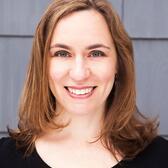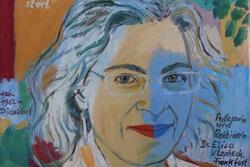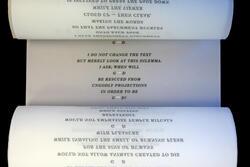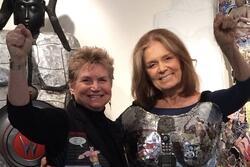Passover, Freedom, and Public Art: An Interview with Julia Vogl
The stand that artist Julia Vogl set up across Boston. Participants would respond to questions about their lives in Boston and their thoughts on freedom and immigration. Each question would correspond to a specific color or pattern. The participant would then be able to take home a pin with a unique design based on their responses. Image courtesy of Jewish Arts Collaborative.
Artist Julia Vogl travels the world, transforming public spaces into works of art that reflect the shared experiences of the local community while embuing those spaces with strikingly vibrant color and patterns. This spring, in a piece commissioned by Boston’s Jewish Arts Collaborative, Vogl will bring her love of color and storytelling to the Boston Common in Pathways to Freedom, a public-art installation inspired by Passover that showcases perspectives on immigration, freedom, and personal history from the Greater Boston community.
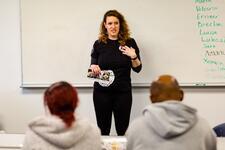
Julia Vogl presenting on Pathways to Freedom. Image courtesy of the Jewish Arts Collaborative.
I was lucky enough to speak with Vogl about her transformative work, her love of color, and how she “puts the public back in public art.”
In a Ted Talk you gave in 2015, you discuss your desire to “put the public back into public art.” How did your relationship to public art and social sculpture first begin?
My interest in public art stems from a confluence of experiences. I worked as summer intern for a high-profile NYC gallery in college and felt it was removed from the community I wanted to engage with art. It seemed that certain gallery work was just for the rich and educated and that rubbed me the wrong way. Soon after this, in February 2005, I got to experience Christo and Jeanne-Claude’s The Gates and was blown away. The big conversion, and my passion, to make public art with community, was working at Public Art for Public Schools under my now mentor Michele Cohen. She really coined the phrase “putting the public back into public art,” and was a huge inspiration to me in understanding both the power of public art and the process of commissioning, contracts, community boards, and collaborating with artists and architects to make large scale work for public spaces. I saw artists make incredible work and I also saw the shortcomings of not involving the community enough––these experiences were my drive when I set out to get my MFA, and ultimately led to me making social sculpture.
The collaborative nature of your work speaks to a faith in the public’s participation. It also introduces a level of uncontrollability in the finished work. How do you manage the uncertainties of creating art in collaboration with the public?
As an example, Pathways to Freedom showcases how many decisions I make to ensure a high-quality aesthetic work. Even if I am not totally sure what it will look like, I do actually hold a lot of control. I designed all the images, the framework, and––at the end––I designed the scale.
I enjoy the democratic nature of my projects––and not totally knowing what will happen––I think the public is further encouraged and empowered to participate because I do give them my trust. It’s critical, however, to know that I don’t ask the public to be artists; I ask them to be decision makers, to be self-reflective, and to be a little bit creative.
How do you decide which colors or patterns will represent what? Does knowing that these installations live on in public spaces affect what colors or patterns you select?
David Batchelor has this theory that, especially in the Western world, we have “Chromaphobia.” In essence, we are afraid of color. I have read enough color theory to know how impactful color, and pattern, can be and I continually strive to fill places that are lacking in color, to perhaps combat this phobia and encourage more positivity.
I have been inspired by so many artists who work on a large scale with color. Color has a phenomenal impact on our moods, our perception of safety, and our ability to embrace our inner curiosity. There are so many things in our world that also do this. If you see a bouquet of multi-coloured balloons, how can you not smile? I do a lot of evaluation when linking colors and patterns, but it’s also a gut reaction. I just read the world in colors. For me, some things just have to be a certain color, and I want to share the way I see the world with others. I do have a more lengthy explanation for why I choose the patterns and colors for this project.
In creating Pathways to Freedom, what inspired you about the Passover story? Did the story, and the setting of Boston, change your ideas of freedom? How did thinking about the immigration experience influence what questions you chose to ask the public?
This project is personal, it’s political, it’s been designed for Boston and its most definitely about Passover!
Many levels of this project were inspired by the story of Passover. From big picture ideas, like the concept of freedom, to the tiny detail of the pin being designed to look like a seder plate.
Very simply, the Exodus story is the tale of people leaving slavery, crossing a body of water, and ending up in tents for 40 years trying to discern their new identity and find home. To me, that emulates perfectly the current refugee crisis occurring worldwide. My own grandparents were refugees during and after WWII; my mother’s parents met in a displaced persons camp. I have been involved volunteering with refugees in London for a while because I believe the only reason I am here today is the kindness of strangers helping my grandparents, coupled with my grandparents’ bravery. They moved countries, crossed bodies of water, and ended up in camps trying to determine their new start. Immigration, or the movement of people, is at the crux of the Exodus story.
America’s history, and Boston’s beginnings, are full of immigration stories. When asked to make a Passover-themed project that was accessible to all of Boston, not just the Jewish community, I knew I had to ask about immigration. When President Trump got elected, that term took on negative connotations. As a first-generation American in my family, immigration has always been a point of pride for my American-Jewish identity. My Hebrew-school education was littered with stories of Jews fleeing their own exodus to America over and over and over again in the 19th and 20th centuries. My parents, who came to seek a better opportunity, felt welcomed and at home in a country that was made up entirely of others. At Seder we welcome the stranger. Growing up in Washington D.C., America always stood for welcoming the stranger––and now that sense of welcoming is under great threat.
This project is about engaging with all the communities across Boston, so that the areas that seem separate in their hamlets––from Dorchester to Newton––are united in a common relationship to Freedom and Immigration.
The four questions I ask in my project were designed to be accessible to everyone, from ages 8 to 98, to someone who is Jewish and to someone who has never heard of Passover. The first question asks, “When did you or your family come to the Boston area?” Just like at Seder, I saw families come together over the iPad and project kiosk to discuss their family story and answer this question.
For each answered question, the participants collect stickers. The stickers are placed on a pin that has seven sections. While a traditional seder plate holds six items, in modern households it seems we are always adding something: an orange, an olive etc. The pin, like a modern seder plate, has seven components to hold your own addition. The first answer has stickers related to Boston landmarks. The last question asks, “If freedom were symbolized as a food what would it be?” (It wouldn’t really be a Passover project if we didn’t talk about food!)
I really enjoyed participating in Pathways to Freedom and getting to bring home my own pin! What is the role of the “anecdotal accessory” in your work?
The pin/button is the legacy component of this project. The Boston Common mural will come and go, but the pin hopefully will live on your jacket or bag for a long time. Like any jewelry, if it’s different enough, it usually evokes a reaction and can be an innocent way to start a conversation with a stranger and ask them about the story behind the accessory. I hope the pin will evoke conversations with family, friends, or strangers about art, freedom, immigration, diversity in Boston today, politics, or just where to get really good food! I believe that wearing this pin can create connections and be a catalyst to unpack large complicated issues. When it comes to refugees and immigration, for many it’s an “out of sight out of mind” conversation. I now have close to 1,800 advocates wearing pins, thereby bringing the conversation to their networks, which I think is cool.
Popular terms like “manspreading” and “mansplaining” highlight the many ways that men feel more ownership of public spaces than women do. How (if at all) does gender factor into your relationship to your work? Why do you think it’s important that women, and women’s art, become a part of public art and social sculpture?
My experience in public art has been that women just approach it differently. I have to be very open to fielding lots of opinions and strategies, and listening to what the community wants to say. I also need to be flexible because when you work with so many partners you can’t be a prima donna, you can’t let ego get in the way. You have to be a team player. Many successful public artists are actually couples. Christo and Jeanne-Claude are a perfect example: he was the draftsman but she was the planner, and negotiator. I have to be both.
I think being a woman makes me more approachable when engaging with strangers in bizarre situations, like when I was on the streets of Krakow with a converted pretzel trolley. My whole process is a nurturing one and I see each project like a child. I want to do all the research, put together a good team of partners, and get the proper funding to ensure the project succeeds and can live on without me. It has felt very maternal; I am not sure men feel that way about their projects.
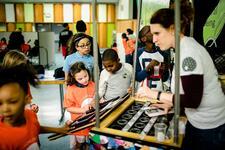
Some of the younger participants in Pathways to Freedom. Image courtesy of Jewish Arts Collaborative.
At JWA, we often talk about the role of stories in sparking change. Your work invites the public to share stories with one another. Why is that important to you? What role do you think sharing stories plays in creating community or making change?
Sharing is empowering. A lot of people want a platform to be heard; that is why social media has been so explosively successful. Ultimately, for me, it’s about visually communicating, transcending backgrounds, and creating a universally and personally accessible piece of art. I am dedicating to showcasing both the individual and collective simultaneously because they enrich each other and illustrate a much more vibrant tapestry and story. We can talk about abstract concepts all we want, but if it’s not personal we don’t relate. Data can seem really impersonal but stories make it personal, and although much of my work is visually abstracted, it’s littered with coded meaning so you can explore the work on several levels. The hope is that you connect and are impacted, and that it maybe changes how you see yourself, others, or the world. If that impacts change––awesome!
My work is about in-person encounters and real placemaking art. If you want to make an impact, you need a lived experience and I think communities come together when they share an experience, good or bad. I am trying to foster beautiful, magical, and positive experiences that bridge disparate people. Telling their stories together is a powerful bridge.
What have been some of your favorite stories and conversations to emerge from the Pathways to Freedom project?
At the cart, I have really enjoyed watching people go from a state of apathy or peer pressure to participate, to deep consideration, to ecstatic joy that they took part. It’s been fun to watch parents explain their family history to their kids and see how that invites all sorts of other conversations. Away from the cart, we actually recorded 103 audio interviews and are editing 44 to include with the actual artwork. They will live on the JArts website after the project. These stories reflect an incredible diversity of people and and their life in Boston.
I had one person after the interview say, “I need a psychiatrist … you really have unleashed some deep thoughts!” More than anything, I have learned how broadly the term Freedom can be interpreted. While it’s a light, euphoric, and liberating term; it’s also weighted in responsibility and fight. It is a heavy burden we continually work to protect. I look forward to the artwork inviting longer conversations on the Boston Common.
Pathways to Freedom will be installed at the Boston Common from April 25 to May 2, 2018.

